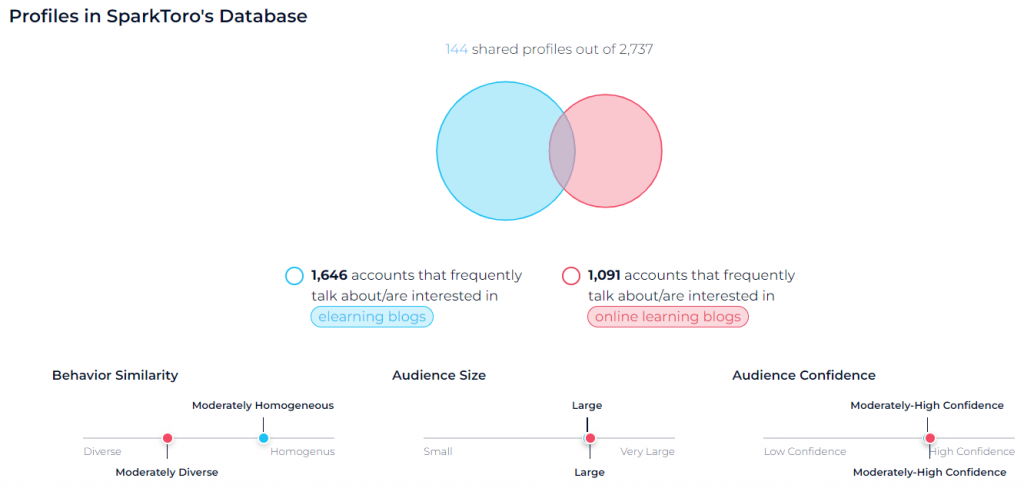There’s a plethora of eLearning blogs and online learning blogs. So, why should you read SoftChalk’s eLearning blog?
There are three key reasons.
1. Our eLearning blog is written for educators like you
First, our eLearning blog is written for college educators, K-12 teachers, and instructional designers, as well as school, college, and university administrators. And having a clear picture of who we are writing for means that our blog on eLearning is much more likely to serve your specific needs and interests than a blog about online learning, which has an audience that’s considerably different.
This isn’t an example of you say toMAYto and I say toMAHto. Words matter.
There are significant differences between the audience that is interested in and frequently talks about “eLearning blogs” and the one that’s interested in and talks about “online learning blogs.” Now, there is some overlap, but it’s a lot less than you might think.
According to SparkToro, an audience research tool, there are 1,646 people with social media accounts, who frequently talk about/are interested in eLearning blogs and 1,091 people with accounts who frequently talk about/are interested in online learning blogs. But, only 144 of these accounts overlap.
If you look at the top phrases used in the bios of the 1,646 people with accounts that are interested in and frequently talk about eLearning blogs, you’ll see:
- educator
- instructional
- school
- designer
By comparison, the top phrases used in the bios of the 1,031 people with accounts that are interested in or frequently talk about online learning blogs are:
- money online
- web
- online learning
- online business
So, these audiences are drastically different.
Now, who are the 144 people interested in both kinds of blogs? SparkToro’s database shows that the top phrases in their bios are: educator, instructional, school, development, and designer. So, it appears that educators are interested in both eLearning blogs and online learning blogs, but marketers are only interested in/talking about online learning blogs.
You can also see how different these two audiences are by looking at the top websites they visit most, the top social accounts they follow most, and the top podcasts that they listen to.
For example, the people who are interested in/talk about eLearning blogs, visit:
- com
- edsurge.com
- teachthought.com
- edweek.org
- educatorstechnology.com
They follow:
- @edutopia
- @elearnindustry
- @Edudemic
- @educationweek
- @LearningGuild
And they listen to:
- MindShift Podcast
- 10 Minute Teacher Podcast with Cool Cat Teacher
- The Innovator’s Mindset (The Podcast)
- TED Talks Daily (SD video)
- TED Talks Art
By comparison, those who are interested/talk about in online learning blogs, visit:
- searchengineland.com
- searchenginejournal.com
- neilpatel.com
- buffer.com
- martech.org
They follow:
- @jeffbullas
- @MariSmith
- @buffer
- @HubSpot
- @MOZ
And they listen to:
- Social Media Marketing Podcast
- Social Media Marketing Talk Show
- Your Digital Marketing Coach with Neal Schaffer
- Marketing Smarts from MarketingProfs
- Content Inc with Joe Pulizzi
According to the audience research tool, there are some websites, social accounts, and podcasts that both audiences are interested in/talk about. So, you may want to read online learning blogs from time to time, but SoftChalk’s eLearning blog is primarily focused on serving people like you. That’s why we hope you will read it regularly.
2. Our eLearning blog prioritizes your informational needs
The second reason why you should read our eLearning blog is its content. Our mission is to provide you with useful information, helpful content, first-hand expertise, a depth of knowledge, product news, and – only occasionally – promotional messages.
Now, many other eLearning blogs have a similar content mix, although some prioritize their organization’s sales/promotional message over their audience’s informational needs.
So, to ensure that you will continue to find our content worth reading regularly, we try to use a combination of what Dr. Sabrina Pack, a Professional Certified Marketer as well as an Associate Professor at Western New Mexico University and an Instructor at New Mexico State University Alamogordo, calls “the 4-1-1 Rule and the 70-20-10 Rule.”
What is the 4-1-1 Rule?
According to Dr. Pack, “What this means is out of every six posts, four of the posts should be about one type of content (such as educational or entertaining content that is new and interesting), one post will be a soft promotion (news, event happening, or shared content, un-gated content), and one post can be a hard promotion with a call-to-action (contest, self-serving post).”
What is the 70-20-10 Rule?
Dr. Pack says this rule guides an organization to have “70% of the posts focused on adding value to the community such as providing relevant business tips, recent happenings, surveys, etc. Then 20% of the content can be from others, such as promoting another’s business or sharing interesting articles written by another and tagging. Then 10% of the content can be promotional and call-to-action in nature such as sales, discounts, introduction on new offerings, etc.”
If you look at recent posts on our eLearning blog, you will see that we’re trying to follow these rules.
- “5 ways SoftChalk helps your online course meet web accessibility guidelines”
- “What you need to look for in an eLearning authoring tool”
- “Top 10 reasons to take SoftChalk’s eLearning content development courses”
- “With CourseSites by Blackboard gone, how can you put courses online?”
- “Non-Traditional Teaching Methods for Non-Traditional Students“
- “Instructional Design Process for Online Learning Courses (Step One)“
We’ve also used SparkToro’s audience research tool and AnswerThePublic, a search listening tool for market, customer, and content research, to ensure that we’re on the right track with an audience-first approach. After reading our content, we hope you will leave feeling you’ve learned enough about an important topic to help achieve your goal.
In addition to using tools to ensure that you will continue to find our content worth reading regularly, we also invite you to let us know if there are specific topics that you’d like us to tackle. Looking for sample lessons created by college educators, instructional designers, and K-12 teachers like you? Want to learn how you can create, manage and share engaging learning content that can be integrated seamlessly with your LMS? Just contact us at learnmore@softchalk.com.
3. Our eLearning blog content is written by educators and experts
The third key reason why you should read our eLearning blog is the expertise of our writers and contributors. They all have backgrounds in eLearning, each is well-trusted, and some are even widely-recognized as authorities on this topic.
For example, the post entitled, “Non-Traditional Teaching Methods for Non-Traditional Students,” was written by Lane Gunnels. He is currently the Program Coordinator for the Electrical Technology Program for South Louisiana Community College. He has been teaching higher education for ten years and has been the recipient of the SLCC “Faculty Excellence in Teaching” award. He has been using SoftChalk for several years and freely admits that he would not be as successful as a classroom innovator if it were not for the features and accessibility of SoftChalk.
The post entitled, “Instructional Design Process for Online Learning Courses (Step One),” was written by Robert Godwin-Jones, Ph.D. He was a founding partner of SoftChalk and responsible for product research and design. He is the former Director of the Instructional Development Center at Virginia Commonwealth University and is currently a Professor in their School of World Studies. He writes a regular column on emerging technologies for the peer-reviewed journal Language Learning & Technology and blogs at Communicating Across Cultures.
And I wrote the post entitled, “With CourseSites by Blackboard gone, how can you put courses online?”
What’s my background?

I got into this field in 1999 when I became the Vice President of Marketing for WebCT. The company’s course tools were originally developed at the University of British Columbia by a faculty member in computer science, Murray Goldberg. His research showed that student satisfaction and academic performance could be improved through the use of a web-based educational resource, or web-based course tools (from which the name WebCT is derived).
WebCT was the world’s first widely successful course management system for higher education. When I got there, the company already had an installed base of 700 institutions in 36 countries, including the University of Georgia, University of Central Florida, UCLA, and the University of Iowa. When I left in 2001, WebCT’s installed base had tripled to 2,172 institutions in 75 countries. The company was acquired by Blackboard in 2006.
So, I initially learned about eLearning as a marketer. But, I also learned some advanced lessons in 2010, when I became an instructor in the Rutgers Mini-MBA programs in Digital Marketing and Social Media Marketing. In fact, I made a few waves when I wrote a blog post for Search Engine Watch entitled, “Why I Returned the Apple iPad Tablet to Rutgers University.”
Now, Rutgers had given brand new iPads to all the students and faculty in their innovative programs, but I returned mine. I didn’t mind being asked to test some bleeding edge technology. But, I thought the early version of the iPad was “a left-handed teaching tool,” because the number of iPad apps for college students and professors was limited.
In 2011, I wrote a follow-up story entitled, “Why I Requested an Apple iPad 2 from Rutgers University.” Now, I hadn’t changed my mind. The iPad had changed to become what I had in mind all along.
As David Pogue of The New York Times said at the time, “You can now connect the iPad to a hi-def TV, thanks to a single H.D.M.I. adapter ($40) that carries both audio and hi-def video. What you see on the TV mirrors whatever is on the iPad, which makes it a great setup for teaching, slide shows, presentations, YouTube and movies. It works automatically and effortlessly.”
Plus, there were finally 65,000 apps for the iPad. Among the ones that I used in the classroom were: Flipboard, OmniGraffle, iMovie, Keynote, and Pages. With these apps, I could use an Apple iPad 2 with either my left or right hand to teach my modules in both of the Rutgers Mini-MBA programs.
Since then, I’ve also taught Digital Marketing and Social Media Marketing modules online as well as in the classroom at Rutgers. In addition, I’ve taught an Influencer Marketing Strategy course that is offered by Rutgers on Coursera, the global online learning platform. So, I have more than 10 years of first-hand experience teaching online – asynchronously vs synchronously.
So, I’m one of that small percentage of people who are interested in and frequently talk about both “eLearning blogs” and “online learning blogs” because I’m an educator as well as a marketer. I hope to offer a different perspective that will complement and supplement what you’ll read from the other educators and experts who will be writing for SoftChalk’s eLearning blog.
In addition, if you’re interested in sharing your experience and expertise, then contact us at learnmore@softchalk.com. Become a part of our dynamic eLearning community.


Leave a Reply